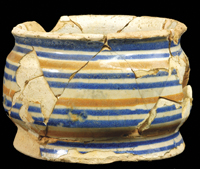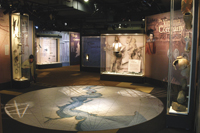Historic
Jamestowne: Piecing Together Our Past
by
Audrey Hingley, Contributing Writer
Photos
Courtesy of APVA Preservation Virginia/Historic Jamestowne
Visit
www.historicjamestowne.org
|

Bill
Kelso
|
Years before the first
fascinating fragments were unearthed, archaeologist Bill Kelso (left)
believed the James Fort was right under our noses.
For Dr. William M. Kelso,
director of archaeology for the Jamestown Rediscovery Archaeological
Project, the importance of Jamestown, Va., is simple.
The
United States, as we know it today, �was
born on the banks of the
James River
at a place called James Fort in 1607. For anyone who wants to come to Jamestown,
it�s here. That�s what we discovered,� Kelso says.
Long thought to be washed
away via erosion into the adjacent James River, the original three-sided
James Fort was the missing piece of
Jamestown�s historic puzzle. �I was going around
saying the fort was here when I was in graduate school. I thought the
evidence wasn�t there to prove it [the fort] wasn�t there,� explains
Kelso, who first visited the site as a graduate student and noticed soil
layers in an exhibit that aroused his interest.
|

Dutch
delftware pharmaceutical jar from the town drainage ditch fill. |
APVA Preservation Virginia
(APVA), the statewide preservation organization in
Virginia
, decided to archaeologically ex�plore the site, which it owns, in
preparation for the 400th anniversary of
Jamestown
�s founding in 2007. Kelso was chosen to head the investigation. To
identify the remains of James Fort required two things: The fort must match
documentary descriptions and there must be proof that the fort dated to the
first decade of the 17th century.
In April 1994, armed with a
shovel, wheelbarrow and �a cheap little video camera� to record any
historic moments, Kelso had only dug a few inches before 17th-century
fragments appeared. Digging continued in a series of 10-foot squares and by
1996, the discovery of a wall trench, curved bulwark palisade and ditch
suggested that the James Fort had indeed been found. The acre-size fort
still retains the remnants of much of its structure, including palisade
walls, bulwarks, interior buildings, and a well.
The dig continues to gain
momentum: Today, more than 60 people, including volunteers, work at the
site. More than a million artifacts attesting to the variety of the
colonists� life have been catalogued, as well as human remains of early
leaders and settlers. Kelso�s new book, Jamestown The Buried Truth (University
of Virginia Press), which chronicles the discoveries, was released last September and is
already in its fourth printing. The book took three years to
complete.
In a dust-jacket notation,
Carter L. Hudgins, early American culture professor at the University of
Mary Washington, notes, �What Kelso and his team have found there since
the first shovel was turned is nothing less than astounding ... evidence of
everything that was built, abandoned and then lost during Jamestown�s
first decades survived, literally inches beneath commemorative statues of
John Smith and Pocahontas.�
Best-selling novelist
Patricia Cornwell, whom Kelso says has �really helped this project and has
funded a lot of it,� calls his book �the autopsy of
America.� She notes that without what she terms �Kelso�s almost mystical
vision� that the site still existed, �we would have little to rely on
but legend to tell us how modern America
began.�
Jamestown
was a commercial venture sponsored by The Virginia Company, a group of
British entrepreneurs supported by King James I, in search of a water route
to the Orient, gold, adventure and a place to convert the natives to
Christianity. The three ships that landed at Jamestown
in May of 1607 transported 108 men and boys intent on gaining a New World
foothold; 104 survived the nearly five-month journey. James Fort was erected
in an incredible 19 days, its wooden walls forming a triangular barrier
around the settlement. Some logs weighed as much as 800 pounds.
In 1619 an assembly of
elected representatives met on Jamestown
Island, the first elected government in what would eventually become the
United States of America. By 1620, the year Pilgrims reached Plymouth Rock, there were already
thousands of settlers living in
Virginia.
|

The
Archaearium at Historic Jamestowne opened in 2006. |
Since the 1950s there have
been two �Jamestowns.� Jamestown Settlement, run as a living-history
park by the Jamestown-Yorktown Foundation, a state agency, was established
in 1957. Historic James�towne, where James Fort was discovered, is the
original site where the first colonists settled. In the 19th century,
Jamestown
reverted to farmland and Confederate earthworks were created during the
Civil War to provide defense against Union gunboats. In 1893, private
landowners donated 22� acres to APVA; in 1934 the National Park Service
(NPS) acquired the remaining 1,500 acres and works jointly with APVA to
operate the site. More than 300,000 people visit the site annually; APVA
administrator Ann Berry notes, �We have already seen an increase in
attendance recently ... everything we do here is to help visitors have a
sense of place and connection to the people that were here 400 years ago.�
Unlike Jamestown
Settlement, a living-history attraction ablaze with colorful flags, costumed
guides and replicas of the three ships that sailed from England, Historic Jamestowne is more low-key. Sitting on a bench on a windy day
watching the James� muddy swells, it�s easy to imagine 1607 and the
world those early residents encountered.
Peace and calmness surround
Historic Jamestowne. A walking bridge from the visitors� center to the
site itself crosses a quiet marsh filled with the sounds of frogs and water
birds. A large statue of Captain John Smith faces the river and visitors can
watch activity at the various dig sites. There�s a statue of Pocahontas
and a row of stark wooden crosses marking settlers� remains.
The Archaearium, a
7,500-square-foot museum that debuted last year, displays more than 1,000
artifacts unearthed in site excavations. Thousands of European pottery
fragments have been found, as well as �precisely datable� items such as
three coins dated 1560-1602. One exhibit hall includes glass cases
displaying human remains, some of which feature accompanying facial
reconstructions like those used to identify modern crime victims. DNA
analysis, computer manipulation and forensic sculpture have taken their
place alongside artifact recovery in the new world of archaeology, allowing
modern man to come face-to-face with
Jamestown
�s people.
One big question: What took
so long to find the original fort? �Everyone
had decided the fort had washed away. The NPS did a couple of tests and
concluded it was not here ... they actually came within inches [of where it
was],� Kelso says. �And the APVA kept this [site] more as a shrine.�
He adds that most NPS
personnel in the past had been trained to dig prehistoric or Indian sites:
�Not many people were looking at American history with a shovel. But there
has been so much development in Virginia
and the Chesapeake
area, these sites from the 17th century are turning up all over the place.
People are beginning to learn about that forgotten era of American
history.�
The
Settlers� Fate
The winter of 1609-1610,
known as �the starving time,� has been horrendously captured via the
excavations. Excavators discovered poisonous snake vertebrae, musk turtle
remains and the bones of rats, horses, dogs and cats. At the end of the
�starving time,� only 60 of the 215 people believed to be residing there
were left alive.
�The dogs were good
hunters and horses were part of their military defenses ... so when you take
[eat] those creatures, you have to be in bad shape,� Kelso observes.
Another highlight for
Kelso: finding what is believed to be the remains of Captain Bartholomew
Gosnold, complete with a decorative iron captain�s leading staff. Gosnold,
who died at age 36 a scant three months after arriving in Jamestown, was the �key person� of
Jamestown, Kelso says.
�He got the people over
here, and he was the most respected of all the leaders,� he explains.
The quest to positively
identify Gosnold took Kelso to Suffolk,
England, when genealogical research led to relatives� gravesites. In the end
there was not a perfect DNA match but there is reason to doubt that the
English �relative� sampled may in fact not be a Gosnold relative.
�I am not too concerned
about being able to scientifically identify those remains,� Kelso says of
the skeleton on display in the Archaearium. In fact, in his book Kelso calls
the process itself �a significant achievement ... the fact that DNA could
survive in burials over three centuries old and survive to the degree that
it was even possible to compare samples from two graves separated by an
ocean is a milestone.�
Another finding: the
discovery of a brick-lined well, whose shaft held nearly 1,400 objects,
including a full suit of armor, scattered over seven distinct layers. Water
testing found that the
Jamestown
water today is clean enough to meet modern drinking-water standards. Kelso
writes, �It is likely that [George] Percy, who was acting governor of the
settlement during the �starving time,� would blame the deaths on his
watch on something other than shortage of
food.
�Percy said the salt ooze
was so close in the marshes that it got in the water. We�ve put a bunch of
[well] shafts out there to test different areas, and the ones we have done
[the bad water reports are just not true],� Kelso says.
Amid
all the stories in The Buried Truth, Kelso has bigger points to emphasize. �The
biggest misconception about Jamestown
is that it was a disaster. But this was a vibrant community and it
succeeded. It did not fail! The Virginia Company failed but the colony did
not fail,� Kelso emphasizes. �The old story that said Jamestown
was a failure and nobody knew what they were doing ... a lot of people lived
and they did a lot of things right.�
For More Information:
(757)
229-1733; www.apva.org
www.historicjamestowne.org